Pilates is a set of exercises created by the German called Joseph Pilates in the mid-1920s, which are performed in solo or in exclusive equipment, which aims at total and complete control and connection between body and mind, returning and restoring the health of individuals in pathological conditions as well as promoting an increase in the quality of life for healthy people.
To help you better understand this growing Method, we have gathered the main information on what Pilates is, about who Pilates was, and how to put together various exercises and videos that you can use in your Studio with your students .
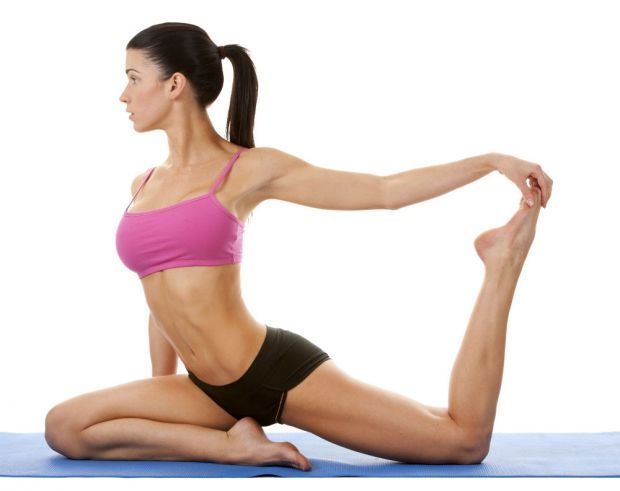
(Photo Credits: Google)
Pilates is a rising field in the world. In Brazil alone, we currently have around 35,000 studios growing. Introduced in the country in the early 2000s, Pilates still sounds like a novelty to many people, even though it already has thousands of Brazilian fans.
As practice moves through the country, with growing public, it becomes an interesting niche for professionals in the area of Physical Education and Physiotherapy.
Ever thought that Pilates can give your career a new gas or leverage your business?
Being relatively new, Pilates still raises many doubts in ordinary people and even in professionals. That is why we have prepared this article for those who would like to know more about this technique created by Joseph Pilates.
For those who have never practiced, Pilates exercises surprise by the softness, because they do not have high impact like other physical activities.
The method still guarantees physical conditioning and can be used for physical rehabilitation or as an alternative to fitness and even weight loss and muscle definition.
For example, women with silicone prostheses can do the exercises without any kind of restriction. Except, of course, if breast augmentation surgery has been performed recently. In this case, it is necessary to wait around 3 months to return to practicing physical activity.
For example, women with silicone prostheses can do the exercises without any kind of restriction. Unless clear if breast augmentation surgery has been performed recently. In this case, it is necessary to wait 3 months to re-engage in the activity.
The main advantage of the practice is that it is accessible to all people, from a high-performance athlete to seniors with reduced mobility. Children, pregnant and disabled can also practice.
With more than 500 types of exercises that can be practiced in the most varied intensities - from basic to super advanced, Pilates is accessible to anyone because it respects individual abilities (and needs) above all else.
No movement is done automatically or passively, but rather with awareness, precision and technical rigor.
Who is Joseph Pilates?
Joseph Hubertus Pilates was the creator of Contrology - that's right, this was how the Method was called and was created and later known as Pilates Method.
The latest books say that his real name was Hubertus Joseph Pilates, but we do not want to be controversial now.
He was born in a small German town called Monchengladbach, near Dusseldorf, on December 9, 1883.
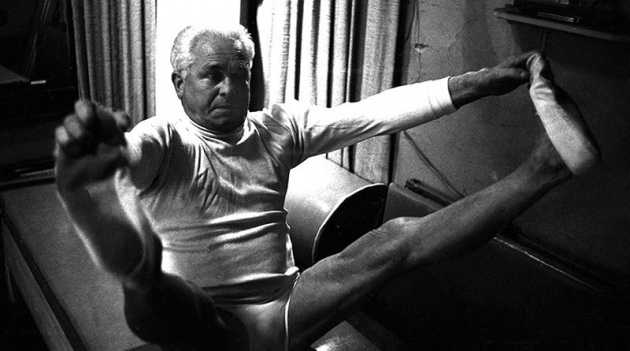
(Photo Credit: Google)
Her father was an award-winning gymnast, and her mother worked as a naturopath - they are people who prefer to use natural remedies, such as herbs and food instead of surgery or synthetic drugs - then we can say that Pilates has grown up amid physical activity and the importance of body's health.
As a child, Joseph Pilates was a very sick child suffering from asthma, rickets and rheumatic fever, and so devoted his life to improving his physical strength.
He became self-taught and deepened his knowledge of anatomy, physics, biology, physiology, and traditional Chinese medicine. From there he decided to dedicate himself to the practice of physical exercises in order to obtain a strong and healthy body.
Pilates focused on respiratory techniques to help with asthma and exercised in outdoor shorts to treat rickets (disease caused by a vitamin D deficiency). From there derive his famous photos practicing only Pilates of shorts. At age 14, his body was already so developed that he posed for an atlas of anatomy.
Already in his adulthood, when he was 32, Joseph Pilates migrated to England where he worked as a professional boxer. At the same time, he was invited to teach self-defense to the detectives of Scotland Yard (Metropolitan Police Service).
However, only two years after moving to the United Kingdom, World War I began, and being considered an enemy of the fatherland for being German, Joseph was arrested and sent to a concentration camp on the Isle of Man where he began to develop the Pilates Method.
During his life Joseph Pilates kept his body in shape, with an excellent physique even in old age and his photos prove the results of the exercises and his healthy lifestyle. You can see photos of Joseph at 80 years in the snow in his trunks or even doing the whole sequence of exercises.
(Video Credit: Youtube)
What are the biggest benefits of Pilates?
The method works with 6 basic principles, important to be listed to take us to the benefits, are: concentration, breathing, centralization, precision, control, fluency.
That said, it is easy to imagine what are the benefits of Pilates, in this section we will mention some of them.
The benefits of Pilates to the body are numerous, some of them like:
- Increases physical and mental stamina
- Increases Flexibility
- Improves column deviations
- Treats pathologies
- Increases cardiorespiratory fitness
- Decrease or end pain
- Enhances sportsmanship
- Corrects postural problems
- Increases concentration
- Tones the muscles
- Improves motor coordination
- Promotes lower joint friction
- Relieves muscle aches
- Helps improve breathing and flexibility
- Helps prevention against osteoporosis
- Promotes relaxation, well-being and elevates self-esteem
- Eliminates toxins and facilitates lymphatic drainage
- Improves posture and muscular endurance
- Expands body awareness
- Help in weight control
- Strengthens the abdominal muscles
- Treats ankle, knee, hip, shoulder and shoulder disorders
By having these gains for the body, Pilates can be used as a treatment for chronic pain, problems related to poor posture, musculoskeletal disorders, injury prevention, increased physical fitness and also for weight loss.
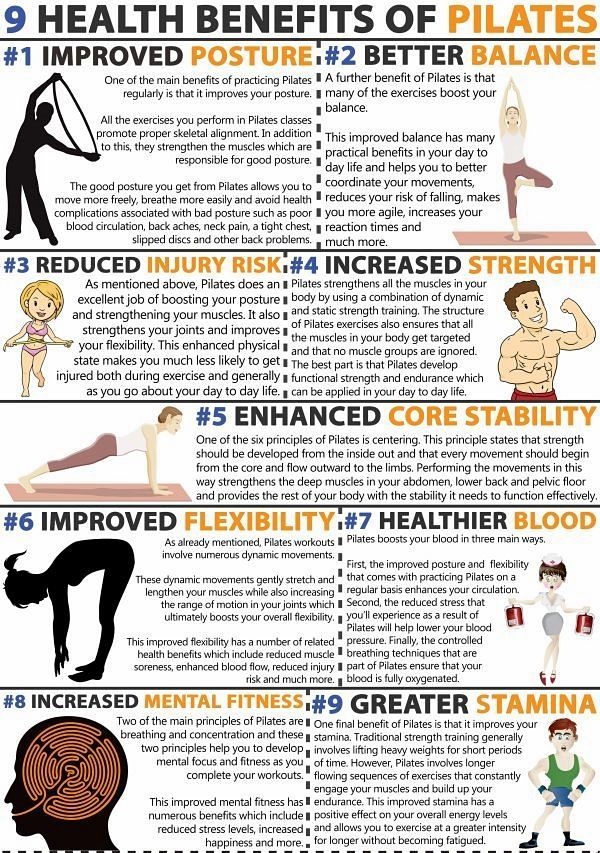
(Photo Credit: Google)
In most exercises, weights are not used and all the effort comes from the load of the body itself.
But according to the objectives of each student, accessories can be used to boost the exercise and also the equipment springs, which can serve to aid or hinder a movement.
With class walking, the student develops a greater body awareness, rediscovering their balance, progressively improving motor coordination and flexibility.
As three-dimensional breathing works, meaning that your rib cage moves in 3 directions - expanding sideways, forward and back, up and down, Pilates also strengthens the respiratory system and circulation.
In addition, the chance of injury is practically nil, since the proposed exercises have low impact and are not repeated to exhaustion.
Thus, there is less body wear, but with all the benefits of practicing physical exercises, such as increased disposition.
It is up to the instructor to chart the strategies according to the student's goals, be it to treat some pathology, increase physical fitness or improve posture.
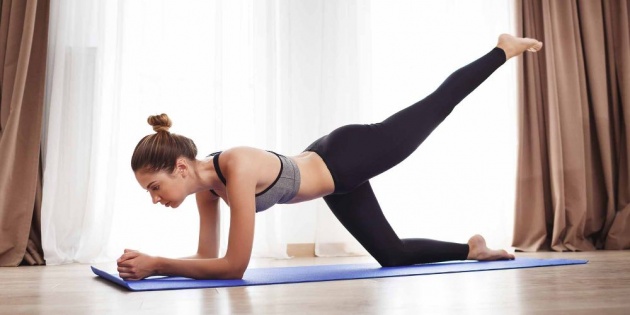
(Photo Credit: Google)
Pilates offers many possibilities and brings different benefits, depending on where you want to go.
When we speak of Pilates's benefits to the mind, we enter into the origin of the method, for while developing his method, Joseph Pilates came into contact with the Eastern theories that preach the integration between healthy body and mind for the maintenance of the body's health.
Therefore, a fundamental part of the practice is the control of breathing and concentration, brought largely from yoga and traditional Chinese medicine.
Just as it regulates the stress-related hormones in the blood, the practice releases dopamine and serotonin, neurotransmitters responsible for the feeling of pleasure and well-being.
As one of its pillars is maintaining focus and attention, it also contributes to an increase in the emotional control of its practitioners.
On top of all this, including a welcome addition of discipline, practicing Pilates can boost self-esteem as changes in the body appear.
Pilates makes you loose weight? Myth or truth?
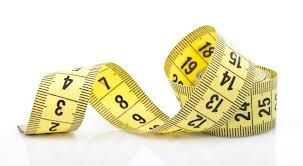
(Photo credit: Google)
Whether or not Pilates slims, it will depend a lot on how it will be taught during classes, but we must remember that as a physical activity, it will always have a considerable energy expenditure.
One of Joseph Pilates's phrases that fits nicely in this context is that he says
It does not matter what you do, it's how you do it.
Associated with the practice of Pilates, an aerobic program as well as a balanced diet are also necessary so that the effects on the balance begin to appear more quickly and effectively.
With the practice of the Pilates Method, the student has his metabolism accelerated because the internal organs are stimulated and these improve our functioning so as to get faster to the body's responses.
Some changes in the body can be noticed with the beginning of Pilates practice.
Among them we can mention the strengthening of the muscles of the legs and the arms, as well as a narrowing in the diameter of the waist and modeling of the buttock.
All these positive changes in the body do not necessarily indicate that the individual has lost weight, however, they weigh on the psychological factor, which in itself also influences the weight loss factor.
The intensity of the lesson and the periodization of the training are the fundamental factors to define the weight loss in the Pilates class.
If the class is devoted entirely to weight loss, the student can eliminate up to 420 calories in a single session if it is high intensity.
The Pilates instructor, however, has a very important role in the preparation of the lesson plan, and the content to be taught, as well as motivate your student with dedication and determination, proposing to each class new exercises, so that the student feel challenged to fulfill them.
It is up to the instructor to use Pilates class for weight loss, if you use accessories and materials such as tonning balls, and also free weights, working the body muscles in an integral and fluid.
Remembering that some of these accessories were not created by Joseph Pilates, but certainly help a lot if the target is weight loss.
The goal will always be for the student to see results after certain sessions.
Are you ready to start Pilates today?
I'll leave you with a 20 minutes class of pilates that you can do at the confort of your house.
Make sure you follow every instruction to make sure you don't injure yourself.
ENJOY IT!
(Video Credit: Youtube)



